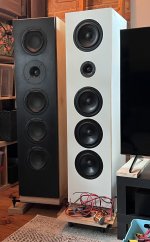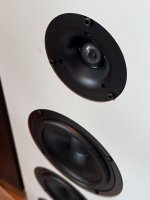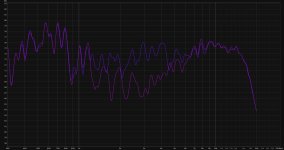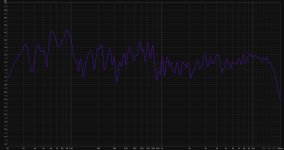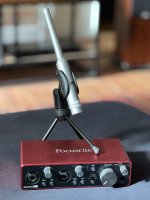Nice, but are we getting things a bit too of topic? At least I try to make things relatable to speakers as it's the Elsinore thread. We need to find a way to test amplifiers (tubes or SS) when connected to something other than dummy loads. We use amplifiers to test speakers, but we don't use speakers to test amplifiers. This is the most complex interface in audio. For a start, come of a way of measuring amplifiers when a real speaker is connected.
Now let us see what comments that generate? 🤔
Nice, but are we getting things a bit too of topic? At least I try to make things relatable to speakers as it's the Elsinore thread. We need to find a way to test amplifiers (tubes or SS) when connected to something other than dummy loads. We use amplifiers to test speakers, but we don't use speakers to test amplifiers. This is the most complex interface in audio. For a start, come of a way of measuring amplifiers when a real speaker is connected.
You asked for comments.
Oh, so that was a comment? I see. But did yours relate to loudspeakers? If it did, I missed that.
But I have a strange belief that you like what the tube amp does is lower distortion of some yet (by most) unidentified kind. The 'warmth' should be there in the first place. And if it is not, then it is distortion that does not allow you to hear it.
Not much about speakers here either.
Perhaps some of the warmth we hear from speakers driven by tube amps is the variable nonzero output impedance.
+1 on the high(er) output impedance of a tube amplifier; can add the subjective impression of some warmth and fuller bass in some systems. Some listeners prefer this, some do not.
+1 on the high(er) output impedance of a tube amplifier; can add the subjective impression of some warmth and fuller bass in some systems. Some listeners prefer this, some do not.
Yes, I hear you and some time ago I would have gone along with that. But... now I am not sure that explains warmth in tube amps. Now I am mnore questioning. Actually, tube amps often increase the midrange (vocals), I have seen speaker impedances as high as 30 Ohm and that increases output. Does increased output there cause warmth? The higher output impedances means that the alignment of the bass is changed. Add resistors and see if it adds warmth. I suspect not. The answer is likely more complex than that.
David and Goliath. Purifi/Scan-speak vs STX/Morel.
One of my friends wanted Elsinore loudspeakers badly, but unfortunately needed to cut costs. So I took up the challenge and built a set based on speakers from the Polish manufacturer STX and a Morel tweeter.
https://stx.pl/w-18-200-8-mcx.html . STX is about $25 per speaker.
https://www.soundimports.eu/en/morel-cat-378.html
Thanks to the extensive knowledge of the builders of this structure on this forum and the information contained on Joe's website, I tried to get the tuning of the kit as close as possible to the original Elsinores.
Many of my guests who had the opportunity to compare both sets noticed that they don't sound the same but it's not easy for them to decide which one is better 🙂
So I consider it a success! In my opinion, it also proves that the design idea behind Joe's design is excellent. The electrical system of the crossover obviously differs in the values of the elements and it took me some time to find a way to connect the mid-bass section with the tweeter. Internal damping is also different, stronger. The length of the bassreflex port is also different.
The speakers will soon go to the paint shop. They will also receive a set of target crossover components.
Yes, this is a DIY curiosity from the world of Elsinore speakers.
One of my friends wanted Elsinore loudspeakers badly, but unfortunately needed to cut costs. So I took up the challenge and built a set based on speakers from the Polish manufacturer STX and a Morel tweeter.
https://stx.pl/w-18-200-8-mcx.html . STX is about $25 per speaker.
https://www.soundimports.eu/en/morel-cat-378.html
Thanks to the extensive knowledge of the builders of this structure on this forum and the information contained on Joe's website, I tried to get the tuning of the kit as close as possible to the original Elsinores.
Many of my guests who had the opportunity to compare both sets noticed that they don't sound the same but it's not easy for them to decide which one is better 🙂
So I consider it a success! In my opinion, it also proves that the design idea behind Joe's design is excellent. The electrical system of the crossover obviously differs in the values of the elements and it took me some time to find a way to connect the mid-bass section with the tweeter. Internal damping is also different, stronger. The length of the bassreflex port is also different.
The speakers will soon go to the paint shop. They will also receive a set of target crossover components.
Yes, this is a DIY curiosity from the world of Elsinore speakers.
Attachments
Last edited:
Well, that's very interesting, the Purifi installation at a price of over 3,000 Euros against the variant for 300,- Euros and the result is not a clear winner?
What is the set of devices and connecting cables? and how is the listening room in terms of acoustics? All this can blur the differences. What is another explanation?
From a technical point of view, I would personally put the mid-bass drivers close to the treble. There is a high crossover frequency, low crossover slopes, and the D'appolito location. All this requires the closest location of drivers.
What is the set of devices and connecting cables? and how is the listening room in terms of acoustics? All this can blur the differences. What is another explanation?
From a technical point of view, I would personally put the mid-bass drivers close to the treble. There is a high crossover frequency, low crossover slopes, and the D'appolito location. All this requires the closest location of drivers.
Maybe we shall call them Elsinore light. 😉
I know asking for FR is not fair, but an impedance plot would be interesting, if able.
I have actually used that Morel CAT-378 tweeter in a small 2-Way system that I designed about six years ago. It is also used in DeVore speakers that sell for not little money.

May I still remind people that the "MFC" Elsinore variant is still current. You don't have to do the Purifi "ULD" version. Yes, we all need to live within what means we have.
There is also the aluminium 'hard' cone version coming, but it will be lower sensitivity.
I know asking for FR is not fair, but an impedance plot would be interesting, if able.
I have actually used that Morel CAT-378 tweeter in a small 2-Way system that I designed about six years ago. It is also used in DeVore speakers that sell for not little money.
May I still remind people that the "MFC" Elsinore variant is still current. You don't have to do the Purifi "ULD" version. Yes, we all need to live within what means we have.
There is also the aluminium 'hard' cone version coming, but it will be lower sensitivity.
Last edited:
Are the crossover designs final? Any plans to share the details of your work with the members in here? 😀David and Goliath. Purifi/Scan-speak vs STX/Morel.
The issue of evaluating the sound of a set is never obvious. Especially for less seasoned listeners, or those who just like to listen to music. But these are big sets and they give a big sound, especially in our European houses or flats, which are not always big.
Personally, I know where the weaknesses of a cheap set of speakers are and they are not able to be objectively better than the Purifi. STX speakers do not have the performance of Purifi. This can be felt in the energy that reaches the listener from the speakers. Although not with every musical repertoire you can feel it, but the sound information in the mid and low bass has better articulation with the Purifi. It's rather not strange 🙂 An easy to determine difference is the differently built stereo stage. I don't know why, but I had this feeling when I had the Elsinoras in the ULD and MFC versions next to each other. They didn't play the same.
Generally, it was just a task to minimize costs while trying to maintain quality as much as possible. The masking of the imperfections was done really well. Especially that it is not a comparison of someone's speaker system and then someone else's, somewhere else. Here they stand next to each other and you can switch sets instantly by switching amps or by switching the preamp outputs.
So, no. These are not better speakers for little money. And a trained ear will quickly figure it out. There are no miracles. But the cost difference is already wonderful. Oh, a compromise. However, I consider it very successful.
I am attaching a test measurement with a tweeter reversed polarity test. And measurement in a room of 22m. from a distance of 2m.
Personally, I know where the weaknesses of a cheap set of speakers are and they are not able to be objectively better than the Purifi. STX speakers do not have the performance of Purifi. This can be felt in the energy that reaches the listener from the speakers. Although not with every musical repertoire you can feel it, but the sound information in the mid and low bass has better articulation with the Purifi. It's rather not strange 🙂 An easy to determine difference is the differently built stereo stage. I don't know why, but I had this feeling when I had the Elsinoras in the ULD and MFC versions next to each other. They didn't play the same.
Generally, it was just a task to minimize costs while trying to maintain quality as much as possible. The masking of the imperfections was done really well. Especially that it is not a comparison of someone's speaker system and then someone else's, somewhere else. Here they stand next to each other and you can switch sets instantly by switching amps or by switching the preamp outputs.
So, no. These are not better speakers for little money. And a trained ear will quickly figure it out. There are no miracles. But the cost difference is already wonderful. Oh, a compromise. However, I consider it very successful.
I am attaching a test measurement with a tweeter reversed polarity test. And measurement in a room of 22m. from a distance of 2m.
Attachments
I know asking for FR is not fair, but an impedance plot would be interesting, if able.
Yes. I will try to post tuning results and crossover data. I'll do that once I get around to taking measurements outside on a less windy day. I am also waiting for the target components because a few parts of mine are missing for the impedance compensation circuits.Are the crossover designs final? Any plans to share the details of your work with the members in here? 😀
I forgot to add that this is 1/12oct smoothing.And measurement in a room of 22m. from a distance of 2m.
Indoors and at 2m you will get a lot of room interaction. Here RTA pink noise tests have an advantage, especially if you can do 1/6th Octave, which my ClioFW01 does, but not small money. But maybe there is cheaper stuff available that can do it now?
Now that you say it, I have heard that, thanks for confirming. It does EPDR as well, right?
What external sound card would be the best for REW. Not so much interested in internal cards.
What external sound card would be the best for REW. Not so much interested in internal cards.
How about one of these? I lent one to one of my sons and never got it back.

Hi, I'm quite keen on this project. Does anyone have any idea how these would compare to kef 104.2 or 107.2s sound quality wise?
Using with a solic state amp listening to accoustic, folk, rock kind of music.
Using with a solic state amp listening to accoustic, folk, rock kind of music.
I also have Clio Pocket 2. And of course REW + UMIK-1.
I have the UMIK-1 here, still in the box though, but my main goto mic is Earthworks M30, but I have other mics as well. I use the full Clio FW01 V11 and not the economy (V12?) Pocket, but it is good to see that you have that. Pocket 2 does "RTA bands: 1/3 or 1/6 octave" and that's useful for indoor measurements. I am getting in touch with my middle son Beau (I have three sons) and get that 2i2 back. The M30 should work with that nicely and REW. I am particularly interested in the EPDR. I have emailed Bohdan re SoundEasy including that facility, would be great when modeling the crossover. He hasn't come back to me yet on that.
But what you have done is certainly interesting. The drivers don't look half bad, I am familiar with the CAT-378 tweeter and the 6.5" driver does not look entirely wrotten to me. Certainly the T-S Params would indicate a tuning could be found for that volume of air. But "ULD" is still..., I think it took me about 9 months to develop the "ULD" version. It seems you did well in a much shorter time. 😊
Below is is the "ULD" in stereo setup at the listening position and twin SVS SB-3000 Subs, in my room - not bad if I may say so. The Subs only contribute below 30Hz and 24dB cut-off rate and tweaking the phase for minimum interference - the Subs are largely inaudible until they cut in with appropriate source material. The troughs and peaks below 200Hz are room related and there with or without Subs:
- Home
- Loudspeakers
- Multi-Way
- The "Elsinore Project" Thread
